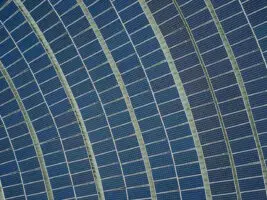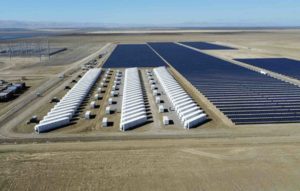An offshore, “open ocean” solar farm co-located with floating wind turbines will be developed off the Belgian coast as part of a major European bid to demonstrate the large-scale, continuous power potential of hybrid offshore marine energy parks.
The €45 million project, called the European SCalable Offshore Renewable Energy Sources (EU-SCORES), will combine the technologies and expertise of 16 project partners led by the Dutch Marine Energy Centre, including RWE Renewables, Enel Green Power and Simply Blue Energy.
A statement from one of the project partners, British offshore engineering company Innosea, said the consortium would start work this month on “two highly comprehensive and impactful demonstrations,” including an offshore solar farm colocated with wind.
Innosea said the 3MW solar system would be developed by Oceans of Energy off the Belgian coast and would be co-located with a “bottom fixed” offshore wind farm.
Oceans of Energy is behind the world’s first offshore solar project – that is, a solar array installed in the open ocean, as opposed to on a reservoir or inland lake – called Zon-op-Zee (Solar at Sea), which was installed in the Dutch North Sea in late 2019.
The Zon-op-Zee system, designed to withstand the extremes of a North Sea environment, was doubled in size in January 2020, from from 8.5kW to 17kW, with plans for further expansions over the course of the year and a view to expand it to 1MW.
An early 2020 update on that project reported that it had “remained stable and intact in all conditions” as it weathered winds of up to 62 knots and waves over five metres high.
The second EU-Scores demonstration will be a slightly more conventional 1.2MW wave energy array by CorPower Ocean in Portugal, co-located with a floating wind farm.
Headquartered in Sweden, CorPower Ocean is behind Wave Energy Converter (WEC) technology “inspired by the pumping principles of the human heart,” which claims to allow a large amount of energy to be harvested using a small and low-cost device.
Statements from the companies said both demonstrations aimed to harness complementary power sources to create a more resilient and stable power system, with higher capacity factors and a lower total cost per MWh.
The demonstrations were also intended to prove how the increased power output and capacity of the parks would reduce the amount of marine space needed for energy generation, leaving more space for aquaculture, fisheries, shipping routes and environmentally protected zones.
“For a successful energy transition we have to move fast without jeopardizing the reliability of our electricity grid,” said Benjamin Lehner, the project portfolio manager of the Dutch Marine Energy Centre.
“The multi-use of offshore space presents a favorable business case with major potential to accelerate the transition, whilst the hybrid approach will enable more reliable electricity provision.
Mattias Lynch, Innosea’s engineering director, said the EU-SCORES project offered the opportunity to leverage cross-sector expertise in wind, floating solar and wave energy to support the innovation of ground-breaking hybrid technology.
“Multi-use of offshore space has the potential to unlock significant operational and cost benefits for the renewable landscape, improving resilience of structures, performance output, and optimal use of marine space,” Lynch said.
Kevin Rebenius, the commercial director at CorPower, described the project as a “truly pan European initiative addressing one of the most important topics of our time, implementing new solutions to accelerate the transition to 100% clean energy.
“We see great value in showcasing the highly consistent and complementary power profile of wave energy, and how this can be combined with wind and solar to deliver a more stable and predictable electricity system based purely on renewables,” he said.
“By generating electricity also when the wind doesn’t blow or the sun doesn’t shine, wave energy can help fill the gaps and thereby become an important part of the mix to stabilise future electricity system.”










